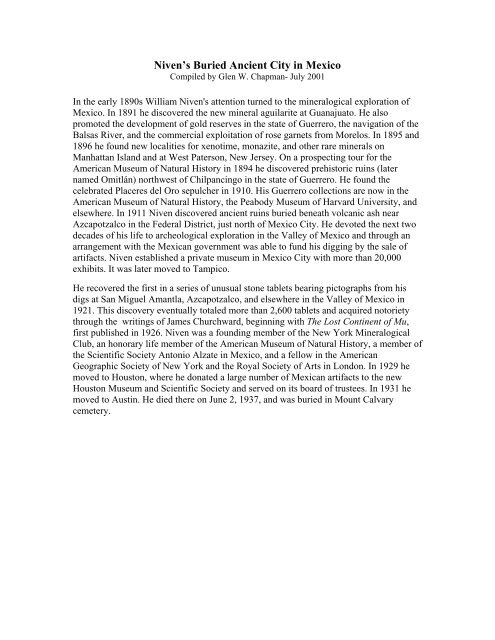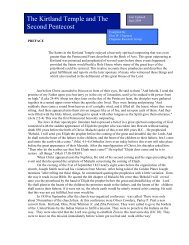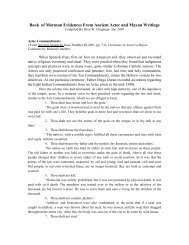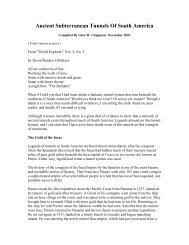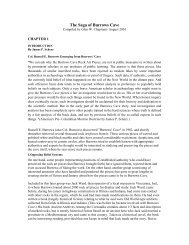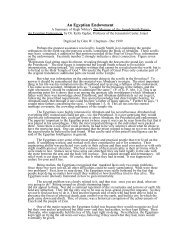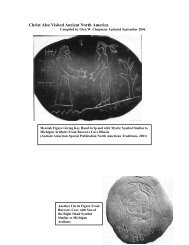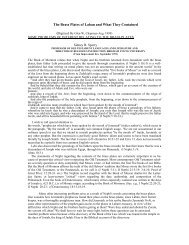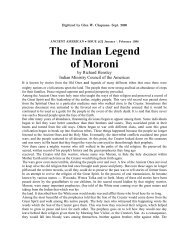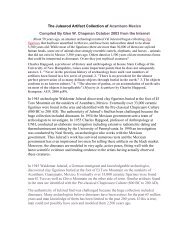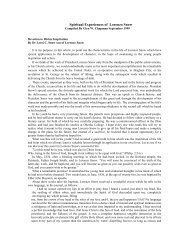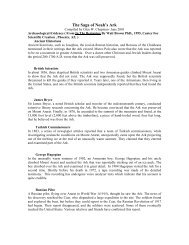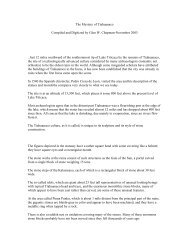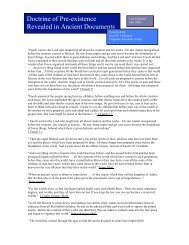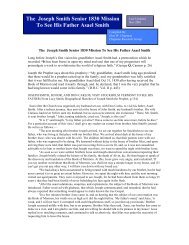Niven's Buried Ancient City in Mexico - Chapmanresearch
Niven's Buried Ancient City in Mexico - Chapmanresearch
Niven's Buried Ancient City in Mexico - Chapmanresearch
- No tags were found...
Create successful ePaper yourself
Turn your PDF publications into a flip-book with our unique Google optimized e-Paper software.
Niven’s <strong>Buried</strong> <strong>Ancient</strong> <strong>City</strong> <strong>in</strong> <strong>Mexico</strong>Compiled by Glen W. Chapman- July 2001In the early 1890s William <strong>Niven's</strong> attention turned to the m<strong>in</strong>eralogical exploration of<strong>Mexico</strong>. In 1891 he discovered the new m<strong>in</strong>eral aguilarite at Guanajuato. He alsopromoted the development of gold reserves <strong>in</strong> the state of Guerrero, the navigation of theBalsas River, and the commercial exploitation of rose garnets from Morelos. In 1895 and1896 he found new localities for xenotime, monazite, and other rare m<strong>in</strong>erals onManhattan Island and at West Paterson, New Jersey. On a prospect<strong>in</strong>g tour for theAmerican Museum of Natural History <strong>in</strong> 1894 he discovered prehistoric ru<strong>in</strong>s (laternamed Omitlán) northwest of Chilpanc<strong>in</strong>go <strong>in</strong> the state of Guerrero. He found thecelebrated Placeres del Oro sepulcher <strong>in</strong> 1910. His Guerrero collections are now <strong>in</strong> theAmerican Museum of Natural History, the Peabody Museum of Harvard University, andelsewhere. In 1911 Niven discovered ancient ru<strong>in</strong>s buried beneath volcanic ash nearAzcapotzalco <strong>in</strong> the Federal District, just north of <strong>Mexico</strong> <strong>City</strong>. He devoted the next twodecades of his life to archeological exploration <strong>in</strong> the Valley of <strong>Mexico</strong> and through anarrangement with the Mexican government was able to fund his digg<strong>in</strong>g by the sale ofartifacts. Niven established a private museum <strong>in</strong> <strong>Mexico</strong> <strong>City</strong> with more than 20,000exhibits. It was later moved to Tampico.He recovered the first <strong>in</strong> a series of unusual stone tablets bear<strong>in</strong>g pictographs from hisdigs at San Miguel Amantla, Azcapotzalco, and elsewhere <strong>in</strong> the Valley of <strong>Mexico</strong> <strong>in</strong>1921. This discovery eventually totaled more than 2,600 tablets and acquired notorietythrough the writ<strong>in</strong>gs of James Churchward, beg<strong>in</strong>n<strong>in</strong>g with The Lost Cont<strong>in</strong>ent of Mu,first published <strong>in</strong> 1926. Niven was a found<strong>in</strong>g member of the New York M<strong>in</strong>eralogicalClub, an honorary life member of the American Museum of Natural History, a member ofthe Scientific Society Antonio Alzate <strong>in</strong> <strong>Mexico</strong>, and a fellow <strong>in</strong> the AmericanGeographic Society of New York and the Royal Society of Arts <strong>in</strong> London. In 1929 hemoved to Houston, where he donated a large number of Mexican artifacts to the newHouston Museum and Scientific Society and served on its board of trustees. In 1931 hemoved to Aust<strong>in</strong>. He died there on June 2, 1937, and was buried <strong>in</strong> Mount Calvarycemetery.
Niven’s <strong>Buried</strong> <strong>City</strong> Show<strong>in</strong>g Strata(From The Lost Cont<strong>in</strong>ent of MU byJames Churchwood, 20 th pr<strong>in</strong>t<strong>in</strong>g , 1963,Crown Publish<strong>in</strong>g, NY ) The buried cityappears to have been built when at sealevel perhaps pre- flood
<strong>Buried</strong> Cities, Forgotten GodsWilliam Niven’s Life of Discovery and Revolution <strong>in</strong> <strong>Mexico</strong> and the American SouthwestRobert S. Wicks and Roland H. Harrison"I will go no further," William Niven’s Indian guide declared. "Beyond on every ridge, as faras you can see is all a part of one great <strong>City</strong> of the Dead . . . the gods will permit no man to gofurther and from here I return."Niven, however, did cont<strong>in</strong>ue on and discovered a remarkable expanse of ru<strong>in</strong>s <strong>in</strong> the ruggedstate of Guerrero along <strong>Mexico</strong>’s western coast. Dur<strong>in</strong>g the early 1890s, Niven’s explorationswere sponsored by the American Museum of Natural History. Later, he cont<strong>in</strong>ued to exploreon his own. His photographs, letters, diaries, and newspaper accounts are now the only sourceof <strong>in</strong>formation on many sites that were later destroyed by grave robbers, neglect, and theturmoil of the Mexican Revolution <strong>in</strong> 1911.His later discovery of twenty-six hundred <strong>in</strong>scribed stone tablets <strong>in</strong> the Valley of <strong>Mexico</strong> arousedconsiderable controversy, and <strong>in</strong>spired James Churchward to put forth an <strong>in</strong>terpretation of the
orig<strong>in</strong>s of the Native Americans <strong>in</strong> The Lost Cont<strong>in</strong>ent of Mu (1926). They rema<strong>in</strong> controversialto this day.The writer Kather<strong>in</strong>e Anne Porter frequented Niven’s excavations <strong>in</strong> the Valley of <strong>Mexico</strong> andbased her first published short story, "María Concepción," on her experiences there. She wouldwrite that the "Old Man never carried a gun, never locked up his money, sat on political dynamiteand human volcanoes and never bothered to answer his slanderers. He bore a charmed life.Noth<strong>in</strong>g would ever happen to him."Niven was plann<strong>in</strong>g a book about his experiences, but was unable to complete it because of illhealth. <strong>Buried</strong> Cities, Forgotten Gods is based upon his surviv<strong>in</strong>g manuscripts and personalpapers.Robert S. Wicks is a professor of art history at Miami University <strong>in</strong> Oxford, Ohio. He haspublished extensively <strong>in</strong> the area of numismatics and monetary history.Roland H. Harrison is William Niven’s grandson and a retired physical chemist from theThermodynamics Laboratory at the National Institute for Petroleum and Energy Research,Bartlesville, Oklahoma.From James Churchwood’s The Lost Cont<strong>in</strong>ent of MU<strong>Niven's</strong> upper city was built before the mounta<strong>in</strong>s were raised at the beg<strong>in</strong>n<strong>in</strong>g of thePleistocene; his lowest city was built tens of thousands of years before this and goes far back <strong>in</strong>tothe Tertiary Era.Niven’s Mexican Bird Tablets . Among Niven’s Collection of 2600 ancient stone tablets, thereare about thirty conta<strong>in</strong><strong>in</strong>g birds. The figure below is Typical.The Figure below shows the use of two sided squares <strong>in</strong> Niven’s artifacts. Aditional Niven tabletsshow eight roads to Heaven. Another figure shows the sides of a cube found among Niven’sartifacts.William Niven’s Own Report of His Explorations ( From Churchwood’s The Lost Cont<strong>in</strong>ebtof MU )“Over an area of about 200 square miles <strong>in</strong> the Valley of <strong>Mexico</strong> from Texcoco to Haluepantla,yhere are hundreds yes thousands of clay pits.After serv<strong>in</strong>g the <strong>City</strong> of <strong>Mexico</strong> as a source for build<strong>in</strong>g materials for more than 300 years, thesepits have enabled me to make an extensive exam<strong>in</strong>ation of a vast ru<strong>in</strong>. Resently my efforts havebeen rewarded with some remarkable and startl<strong>in</strong>g discoveries, which seem to open up a newfield for archelogical research on this cont<strong>in</strong>ent.My Operations have been conf<strong>in</strong>ed to an area some 20 miles long by 10 miles wide, <strong>in</strong> thenorthwestern portion of the great valley. There I have found traces of two civilizations and three
well preserved concrete floors or pavements , each one aat some time underly<strong>in</strong>g a large city.These pavements are at a depth of from 6 to 21 feet from the surface. Above the first there is adeposit of small boulders, pebbles and sand covered with a foot thick coat<strong>in</strong>g of the rich soil ofthe valley. The great age of this upper or younger floor must be pla<strong>in</strong>, when every layman stopssto consider the number of years required to deposit one foot of earth on a level pla<strong>in</strong>. Everywhere<strong>in</strong> this deposit of boulders, pebbles and sand above the first floor I found fragments of brokenpottery, small clay figures, diorite beads, spear and arrow heads, sp<strong>in</strong>dle whorls and otherartifacts, mostly broken.The second concrete floor is from 4 to 6 feet below the first, the difference <strong>in</strong> distancebetween the two accounted for by the broken condition of the lower pavement, due probably, toseismic disturbances. In the <strong>in</strong>terven<strong>in</strong>g space between the two pavements, one and two, I havefailed to f<strong>in</strong>d a s<strong>in</strong>gle piece of pottery, or any other trace to <strong>in</strong>dicate that people had lived there.Underneath the second pavement, however came the great f<strong>in</strong>d of my many years’ work<strong>in</strong> Mexican archaeology. First I came upon a well def<strong>in</strong>e layer of ashes from two to three feet <strong>in</strong>thickness , and s<strong>in</strong>ce proved by analysis to be of volcanic orig<strong>in</strong>. Just below the ashes I foundtraces of <strong>in</strong>numerable build<strong>in</strong>gs , large, but regular <strong>in</strong> size, and appear<strong>in</strong>g uniformly <strong>in</strong> more than100 clay pits , which I have exam<strong>in</strong>ed dur<strong>in</strong>g my recent <strong>in</strong>vestigations.All of these houses are badly ru<strong>in</strong>ed, crushed and filled with ashes and debris. In the pastweek’s work I found a wooden door, the wood of which had petrified and turned to stone. Thedoor was arched with a semicircle l<strong>in</strong>tel, maid by bend<strong>in</strong>g the trunk of a tree about five <strong>in</strong>ches <strong>in</strong>diameter or thickness. This is he first curved arch ever found <strong>in</strong> the ru<strong>in</strong>s of <strong>Mexico</strong>; and , as thewalls of the house were laid of stone, bound together with white cement, harder ttthan the stoneitself, this wooden arch must have been put <strong>in</strong> as an ornament. Cutt<strong>in</strong>g through the door, I came<strong>in</strong>to a room about 30 feet square, filled with almost pure volcanic ash, apparently about the onlyroom strong enough to withstand the terrible weight of soil , ashes and stone above it. The roofwhich had been of concrete and stone, and flat, had caved <strong>in</strong>, but around the lower edges of theroom great flat fragments of this roof had formed arches, little caves <strong>in</strong> the ashes, <strong>in</strong> which werepreserved many artifacts of the dead race. With the artifacts were bones, numberless bones ofhuman be<strong>in</strong>gs, which crumbled to the touch like slacked lime.Above their tomb the waters of a great flood had raged, wip<strong>in</strong>g out another civilization.Flood and the crash<strong>in</strong>g boulders had not disturbed the sleep of this mighty race.The doorway was over six foot deep, and on the floor, thirteen feet from the door, I cameupon a complete gold-smith’s outfit. It consists of a terra-cotta chimney 25 <strong>in</strong>ches <strong>in</strong> height,taper<strong>in</strong>g upwards from a round furnace 15 <strong>in</strong>ches <strong>in</strong> diameter. On the floor around the furnace, towhich still adhered bits of pure gold, I found more than 200 models, which had once been bakedclay, but which had been transformed <strong>in</strong>to stone. All of these were duplications carved on figuresand idols which I found later <strong>in</strong> the same house. Evidently this had been the house of aprosperous goldsmith and jeweler of the better class <strong>in</strong> the ru<strong>in</strong>ed city.Some of the models or patterns were less than one-twentieth of an <strong>in</strong>ch <strong>in</strong> thickness, andwere used for the manufacture of the gold , silver and copper dress, head, breast, arm and ankleornaments which thw statuettes show the people to have worn <strong>in</strong> those days. Each model wasthickly coated with iron oxide, bright and yellow, probably put on there to prevent the moltenmetals adher<strong>in</strong>g to the pattern while <strong>in</strong> the cast<strong>in</strong>g pot…The work is f<strong>in</strong>e, beautifully polished,and shows a hight of civilization fully as great, if not greater, than that possessed by the Aztecawhen the Spanish under Hernando Cortez first <strong>in</strong>vaded <strong>Mexico</strong>.
But what struck me most as the feature of the room was the mural decorations. Evidentlythere had been a slight partition through the center, while from the rear walls the dim outl<strong>in</strong>e ofthe door appeared to lead <strong>in</strong>to another room, which is now so complete a ru<strong>in</strong> that I doubt thatanyth<strong>in</strong>g other than bones will be found <strong>in</strong> it.Here are wall pa<strong>in</strong>t<strong>in</strong>gs done <strong>in</strong> red, blue, yellow, green and black, which compare favorablywith the best photographs I have ever seen of Greek, Etruscan, or Egyptian works of the samek<strong>in</strong>d.The ground color of the wall was pale blue, while six <strong>in</strong>ches down from the fourteen footceil<strong>in</strong>g a frieze pa<strong>in</strong>ted <strong>in</strong> dark red and black ran all around the four sides. This frieze ow<strong>in</strong>g tothe fact that it had been glazed after pa<strong>in</strong>t<strong>in</strong>g, wit a sort of native wax , is perfectly preserved, sofar as colors and patterns go. It has been, however, broken <strong>in</strong> three places by fragments of thefall<strong>in</strong>g roof, but otherwise it is almost as legible as the day when first pa<strong>in</strong>ted. It depicts the life ofsome person evidently a shepherd, br<strong>in</strong>g<strong>in</strong>g him from babyhood to his death bead.Beneath the room I found the tomb of some one of importance, possibly of him whoselife was portrayed <strong>in</strong> the frieze above. In this vault, which was only three feet <strong>in</strong> depth and l<strong>in</strong>edwith cement, were seventy five pieces of bone, all that rema<strong>in</strong>ed of a complete skeleton. Onelarge fragment of the skull conta<strong>in</strong>ed the blade of a hammered copper ax, which had evidentlydealt death to the occupant of the tomb, and which had not been removed by his relatives orfriends. The bones crumbled to the touch, so long had they been <strong>in</strong> the tomb, but there were otherobjects more <strong>in</strong>terest<strong>in</strong>g than the bones.One hundred and twenty-five small clay terra- cotta idols, manik<strong>in</strong>s, images and dishes ofall k<strong>in</strong>ds were ranged around the bottom of the tomb.Among the objects unearthed were over 2600 stone tablets.
Sketch of Some of the Relics from Niven’s Lowest<strong>City</strong> ( From Churchwood’s The Lost Cont<strong>in</strong>ent ofMU )
Niven The Work<strong>in</strong>g of the Primary Forces(Churchwood The Children of MU )Niven Group of Bird TabletsSymboliz<strong>in</strong>g The Creative Forces(Churchwood The Children of MU )
Faces of a 10 <strong>in</strong>ch Cube Among Niven’s Artifacts
Niven The Waters – The Mother of Life(Churchwood The Children of MU )Group of twenty Different Crosses fromNiven’s Tablets
There is a photo of a large monolith Niven found <strong>in</strong> the 1890's <strong>in</strong>Guerrero at Quechamictlipan which has similar <strong>in</strong>scriptions <strong>in</strong> "<strong>Buried</strong>Cities, Forgotten Gods". Along with it, Niven found greenstonefigur<strong>in</strong>es with helmets similar to those dipicted on the Olmecmonoliths of Veracruz. Another described as an altarstone was found <strong>in</strong>a cornfield near Atzcapotzalco when Sylvanus Morely and Thomas Gannwere present. Churchward tried to persuade Niven to guide him to thestone so that it could be transported to the United States but balkedwhen Niven <strong>in</strong>sisted on be<strong>in</strong>g present and wanted five thousand dollarsto cover the expenses of mov<strong>in</strong>g it properly. Afterwards, Churchwardbroke off contact with Niven and apparently went down to <strong>Mexico</strong> to tryand retrieve the stone himself. This would be around 1928. Nivenreturned with his son to dig up the stone aga<strong>in</strong> where he had reburiedit but it had weathered to the po<strong>in</strong>t that mural was no longer visible.It is also stated <strong>in</strong> the text that Niven had sent Churchward 2600rubb<strong>in</strong>gs from the orig<strong>in</strong>al tablets found at Atzcapotzalco, so theseshould be among Churchward's orig<strong>in</strong>al papers.In 1926, Niven recieved a letter from Ludovic Mann of Glasgow whostated that the <strong>in</strong>scriptions were very similar to ones he had studiedfrom Scand<strong>in</strong>avian petroglyphs and that one <strong>in</strong> particular was of thegod Jupiter. Niven sent Mann additional rubb<strong>in</strong>gs to aid <strong>in</strong> hisresearch However, a Canadian l<strong>in</strong>guist who was an expert <strong>in</strong> Aztecwrit<strong>in</strong>g, J.H. Cornyn, wrote Niven from <strong>Mexico</strong> <strong>City</strong>, to tell him thatthe figure was not a man but a woman, Xochi-quetzal, a vegetationgoddes and wife of the old fire god. The symbols below the figure werethe four card<strong>in</strong>al directions over which the goddes had dom<strong>in</strong>ion.Cornyn later warned Niven not to place much confidence <strong>in</strong> Churchward'sdecipherments. At this same time the American Museum of NaturalHistory sent a letter offer<strong>in</strong>g to return numerous tablets fromAtzcapotzalco which Niven had donated to the them. They could not f<strong>in</strong>danyone who who could descipher the mean<strong>in</strong>g among all their experts.Niven felt betrayed by the <strong>in</strong>stitution which had supported and honoredhim so long. He mused that it was because he had given them "a nut tootough to crack" or that someone on the staff had maligned his work.Whatever the reason, this was the beg<strong>in</strong>n<strong>in</strong>g of <strong>Niven's</strong> fade from theworld of academic science.In research<strong>in</strong>g the American Museum of Natural History, I later foundthat on the list of notable past members, Niven is conspicuouslyabsent while his archrival Manuel Gamez is <strong>in</strong>cluded.


